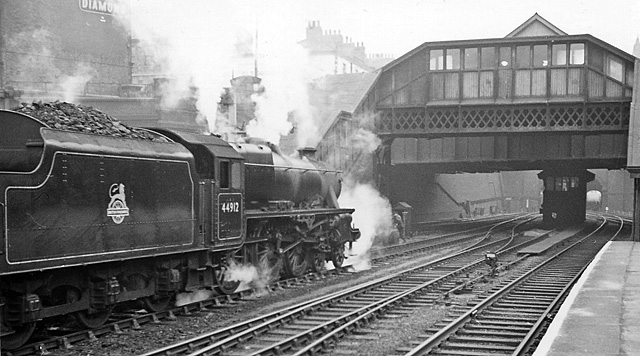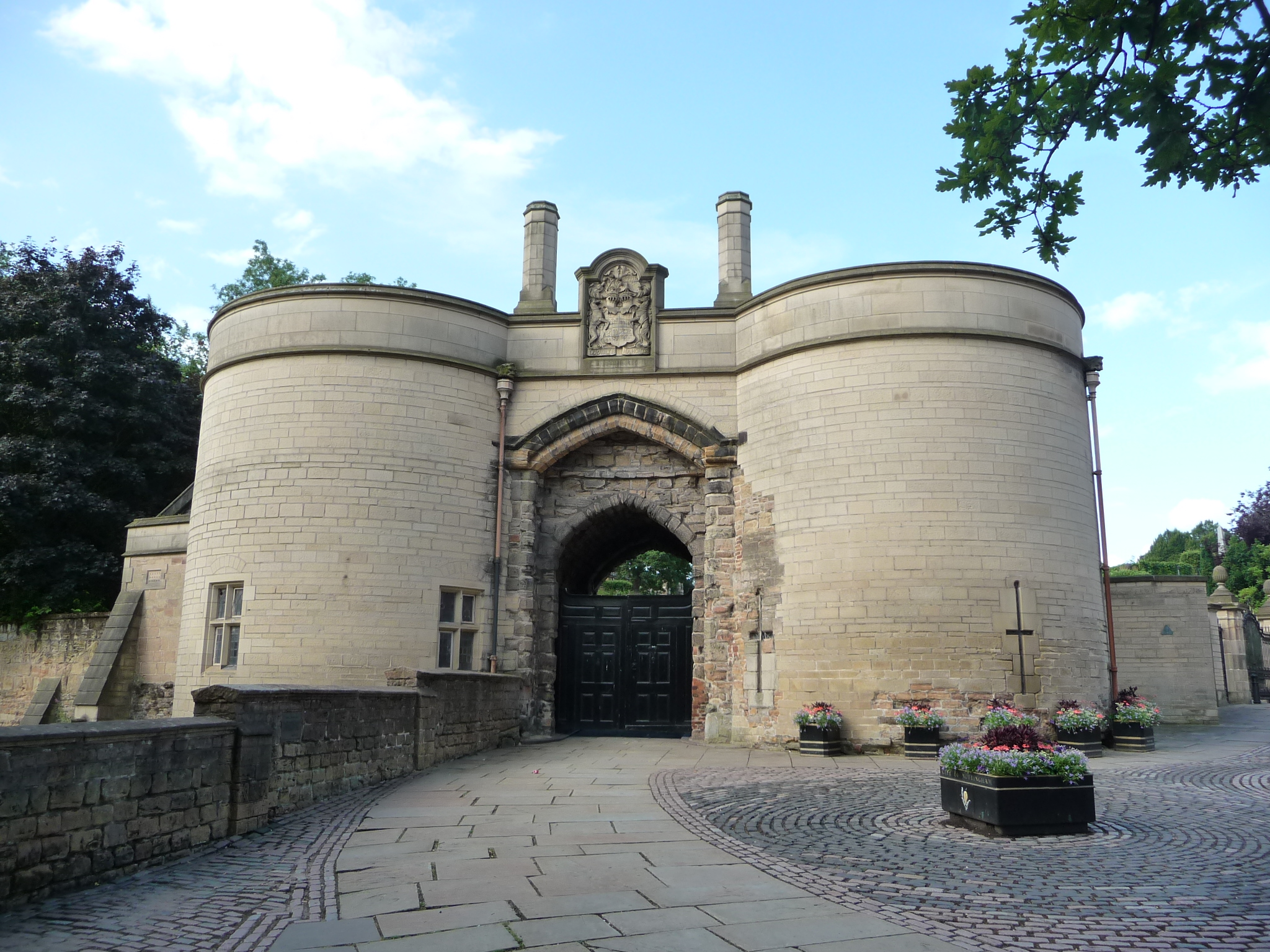|
Basford And Bulwell Railway Station
Basford North railway station was a railway station which served Basford and Bulwell in Nottinghamshire, England. It was close to the River Leen, which the line crossed on a nine-arch brick viaduct. History Built by the Great Northern Railway on its Derbyshire Extension in 1875–6 the station was originally called Dob Park, as it was built on land belonging to that estate, but was quickly renamed to Basford and Bulwell and later renamed again to Basford North in order to avoid confusion with the nearby Midland Railway station originally named Basford which opened in 1848. The station closed to passengers in 1964 and to goods three years later. There were further stations in Bulwell at , and . Station masters *Mr. Snell 1907 - 1910 (also station master at Basford) *J. Davis 1910 - 1922 (formerly station master at Spondon) *Louis B. Parley ???? - 1928 (afterwards station master at Spalding) *T. Hibbert 1931 - ???? *W.W. Capon 1934 - 1936 (afterwards station master ... [...More Info...] [...Related Items...] OR: [Wikipedia] [Google] [Baidu] |
Old Basford
Old Basford is an area of Nottingham Nottingham ( , East Midlands English, locally ) is a City status in the United Kingdom, city and Unitary authorities of England, unitary authority area in Nottinghamshire, East Midlands, England. It is located south-east of Sheffield and nor ... located next to New Basford being split by Valley Road/Western Boulevard. The parish church of St Leodegarius was built in the 12th century. The north aisle and north arcade were rebuilt in 1858–59 and the church restored, except for the tower. The church tower collapsed in 1859 and was rebuilt in 1859–61. Near the church is the Manor House of 1700.Pevsner, Nikolaus. 1979. ''The Buildings of England:Nottinghamshire''. page 266. Harmondsworth, Middx. Penguin. See also * St Leodegarius Church, Basford References Areas of Nottingham {{Nottinghamshire-geo-stub ... [...More Info...] [...Related Items...] OR: [Wikipedia] [Google] [Baidu] |
Basford Vernon Station
Basford Vernon railway station is a disused railway station that was located on the Robin Hood Line between Nottingham and Mansfield. History The station was originally called Basford on the Midland Railway's Nottingham to Mansfield Line and opened on 2 October 1848. Three passenger trains a day in each direction were provided from Monday to Saturday with two on Sundays. The fare from Nottingham to Lenton was 1s. in first class, 9d in second class, and 6d in third class. It was renamed in August 1952 and closed to passengers on 4 January 1960 and to goods on 2 October 1967. In its place now stands the Nottingham Express Transit (NET) Basford tram stop Basford is a tram station on Nottingham Express Transit (NET), in the city of Nottingham suburb of Basford. The tram lines here run parallel to the Robin Hood railway line that links Nottingham with Worksop, but there is no corresponding railw ... which opened on 9 March 2004, along with the rest of NET's initial system. ... [...More Info...] [...Related Items...] OR: [Wikipedia] [Google] [Baidu] |
Railway Stations In Great Britain Closed In 1964
Rail transport (also known as train transport) is a means of transport using wheeled vehicles running in tracks, which usually consist of two parallel steel rails. Rail transport is one of the two primary means of land transport, next to road transport. It is used for about 8% of passenger and freight transport globally, thanks to its energy efficiency and potentially high speed.Rolling stock on rails generally encounters lower frictional resistance than rubber-tyred road vehicles, allowing rail cars to be coupled into longer trains. Power is usually provided by diesel or electric locomotives. While railway transport is capital-intensive and less flexible than road transport, it can carry heavy loads of passengers and cargo with greater energy efficiency and safety. Precursors of railways driven by human or animal power have existed since antiquity, but modern rail transport began with the invention of the steam locomotive in the United Kingdom at the beginning of the 19th ... [...More Info...] [...Related Items...] OR: [Wikipedia] [Google] [Baidu] |
Industrial Estate
An industrial park, also known as industrial estate or trading estate, is an area zoned and planned for the purpose of industrial development. An industrial park can be thought of as a more heavyweight version of a business park or office park, which has offices and light industry, rather than heavy industry. Industrial parks are notable for being relatively simple to build; they often feature speedily erected single-space steel sheds, occasionally in bright colours. Benefits Industrial parks are usually located on the edges of, or outside, the main residential area of a city, and are normally provided with good transportation access, including road and rail. One such example is the large number of industrial estates located along the River Thames in the Thames Gateway area of London. Industrial parks are usually located close to transport facilities, especially where more than one transport modes coincide, including highways, railroads, airports and ports. Another co ... [...More Info...] [...Related Items...] OR: [Wikipedia] [Google] [Baidu] |
Kimberley East Railway Station
Kimberley East Railway Station was a station serving the town of Kimberley in Nottinghamshire, England. History It was opened by the Great Northern Railway on its Derbyshire Extension in 1875-6 It was on the second summit on the climb through Watnall Tunnel from Basford and Bulwell of what was a hilly line, crossing as it did, several river valleys. Passenger services finished in 1964 and the line finally closed in 1968. Following the trackbed of this line takes you to the Bennerley Viaduct. This is a grade II listed structure which is still in place on the Nottinghamshire Derbyshire border. Kimberley's other station was on a line from the Midland Railway's Erewash Valley Line to Nottingham Nottingham ( , East Midlands English, locally ) is a City status in the United Kingdom, city and Unitary authorities of England, unitary authority area in Nottinghamshire, East Midlands, England. It is located south-east of Sheffield and nor .... Stationmasters *Samuel Pac ... [...More Info...] [...Related Items...] OR: [Wikipedia] [Google] [Baidu] |
Daybrook Railway Station
Daybrook railway station was a Train station, railway station in Daybrook, Nottinghamshire. It was opened by the Great Northern Railway (Great Britain), Great Northern Railway on its GNR Derbyshire and Staffordshire Extension, Derbyshire and Staffordshire Extension in 1875–6 and closed in 1960. The station also served the nearby town of Arnold, Nottinghamshire, Arnold. History It was on the descent from Arno Vale towards Leen Valley Junction where the line from Annesley joined. The line between and Daybrook closed in 1960 because of mining subsidence in Mapperley Tunnel. Stationmasters *Charles Frederick Pulford ca. 1877 - 1907 *Thomas Peacock 1907 - 1928 *J.F. House 1928 - 1929 *F.M. Wright 1930 - 1936 (afterwards stationmaster at Peterborough) *Joseph George Watts 1936? - 1944 (afterwards acting stationmaster at Kimberley) *W.H. Arrand 1945 - ca. 1950 - ???? (formerly stationmaster at Arksey, Yorkshire) Present day The site is now occupied by retail and a sectio ... [...More Info...] [...Related Items...] OR: [Wikipedia] [Google] [Baidu] |
Nottingham Victoria Railway Station
Nottingham Victoria railway station was a Great Central Railway and Great Northern Railway (Great Britain), Great Northern Railway railway station in Nottingham, England. It was designed by the architect Albert Edward Lambert, who also designed the rebuild of the Nottingham Midland station (now known simply as Nottingham station). It was opened by the Nottingham Joint Station Committee on 24 May 1900 and closed on 4 September 1967 by the London Midland Region, London Midland Region of British Railways. The station building was entirely demolished (except the clock tower), and the Victoria Centre, Nottingham, Victoria Centre shopping centre was built on the site, incorporating the old station clock tower into the main entrance on Milton Street (the continuation of Mansfield Road). Background In 1893 the Manchester, Sheffield and Lincolnshire Railway obtained authorisation to extend its North Midlands railway network into London. This new line was opened on 15 March 1899 (by whi ... [...More Info...] [...Related Items...] OR: [Wikipedia] [Google] [Baidu] |
Spalding Railway Station
Spalding railway station serves the town of Spalding, Lincolnshire, England. It lies on the Peterborough–Lincoln line. History Spalding gained its first rail links to Peterborough, Boston and Lincoln in 1848, courtesy of the Great Northern Railway (GNR) who built their main line from London to Doncaster through the town; Spalding railway station opened on 17 October 1848. This route was superseded by the direct line via Grantham within four years, but it remained well used by traffic heading towards Louth and Grimsby over the former East Lincolnshire Railway. The GNR subsequently added a line eastwards to Sutton Bridge via Holbeach (the Norwich & Spalding Railway) in stages between 1858 and 1862, a westward route to Bourne in 1866 and another to the following year in an attempt to thwart the ambitions of the competing Great Eastern Railway (GER). These efforts did not succeed however and the company eventually agreed to work these routes jointly with the Midland Rail ... [...More Info...] [...Related Items...] OR: [Wikipedia] [Google] [Baidu] |
GNR Derbyshire And Staffordshire Extension
The Derbyshire and Staffordshire extension of the Great Northern Railway (Great Britain), Great Northern Railway was an English railway network built by the GNR to get access to coal resources in the area to the north and west of Nottingham. The Midland Railway had obstructed the GNR in its attempts to secure a share of the lucrative business of transporting coal from the area, and in frustration the GNR built the line. The line was forked: it reached Pinxton in 1875 and a junction with the North Staffordshire Railway at Egginton, approaching Burton upon Trent, Burton on Trent in 1878. The line cut through Derby, resulting in considerable demolition of housing there. West of Derby the line was primarily agricultural; thoughts that a long-distance connection might build up using the line were over-optimistic, although a limited long-distance goods traffic did run. The GNR served holiday resorts on the East Coast of England, and a considerable excursion and holiday traffic from Derby ... [...More Info...] [...Related Items...] OR: [Wikipedia] [Google] [Baidu] |
Nottingham
Nottingham ( , East Midlands English, locally ) is a City status in the United Kingdom, city and Unitary authorities of England, unitary authority area in Nottinghamshire, East Midlands, England. It is located south-east of Sheffield and north-east of Birmingham. Nottingham is the legendary home of Robin Hood and to the lace-making, bicycle and Smoking in the United Kingdom, tobacco industries. The city is also the county town of Nottinghamshire and the settlement was granted its city charter in 1897, as part of Queen Victoria's Diamond Jubilee celebrations. In the 2021 United Kingdom census, 2021 Census, Nottingham had a reported population of 323,632. The wider conurbation, which includes many of the city's suburbs, has a population of 768,638. It is the largest urban area in the East Midlands and the second-largest in the Midlands. Its Functional Urban Area, the largest in the East Midlands, has a population of 919,484. The population of the Nottingham/Derby metropolitan a ... [...More Info...] [...Related Items...] OR: [Wikipedia] [Google] [Baidu] |






